The 4 Most Important Insights for Marketers from Andreessen Horowitz’s Podcast Market Report
The tech venture capital firm Andreessen Horowitz (a16z) recently released their Podcasting and Audio Market Cap report. Authored by Li Jin (pictured), with help from Bennett Carroccio, and Avery Segal, the 68-page point of view deck will apparently inform the firm’s investing strategy in the audio industry. The slides cover everything from the overall growth of the industry to the existing audio company landscape to, naturally, the exits we’ve seen so far. It pulls heavily from the data reported by Nielsen and my personal go-to source, Edison Research. The latter publishes the longest-running annual report in this industry, the Infinite Dial, alongside partner Triton Digital. The yearly webinar reviewing the data is hosted by the smart, snappy duo of Tom Webster, SVP of Edison, and John Rosso, President of Market Development at Triton, and is well worth everyone’s time.
I dug into a16z’s giant report to pull out four key insights that marketers should know, whether you plan to launch a podcast, currently operate a show, or you’re among those brands leading the way with entire networks, teams, and strategies, like Mailchimp, Shopify, Drift, and Convince & Convert from Jay Baer, just to name a few.
Without further ado, here’s what marketers should know from the report:
1. The Dayparting Opportunity
According to the ‘pedia made of wikis, “dayparting” is the broadcast programming practice of “dividing the broadcast day into several parts, in which a different type of radio or television program apropos for that time period is aired.”
Marketers: This is a massive opportunity, mostly because your competition is likely not thinking about dayparting, preferring instead to run podcasts “every week” or “new each Friday.” Taking a more refined view can help you outright own a certain part of your audience’s week, every week.
Deciding to daypart can help make both creative production AND marketing strategy easier on you and your team, too. In other words, it has real ramifications for brand and audience alike. More on that in a bit. First, let’s look at the data.
The following two slides from the a16z report hint at the need to daypart.
First, note the growth in smartphone listenership compared to other devices:
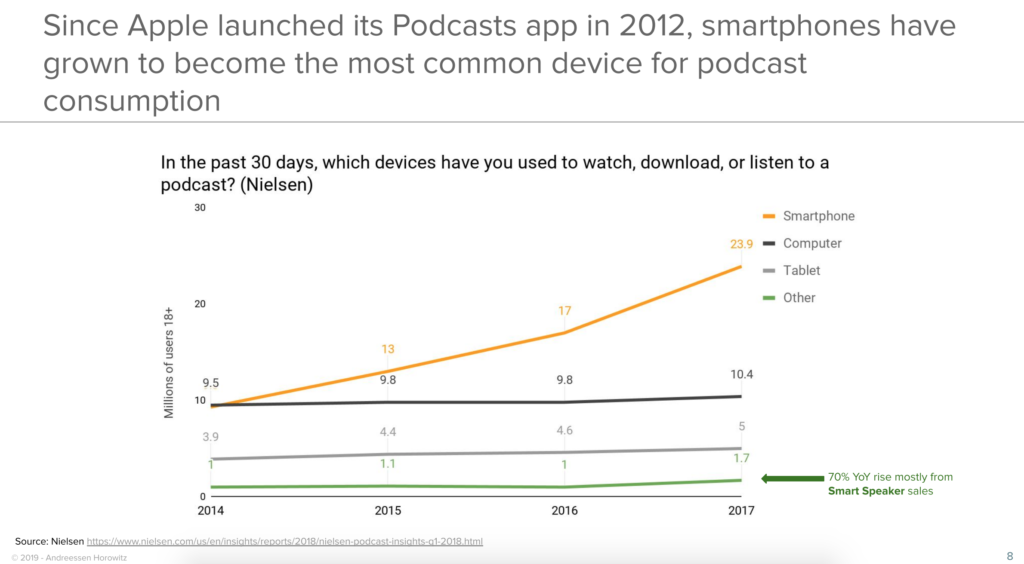
This matches a couple expected trends we’ve all heard about before: more people have smartphones today compared to 2014, and more smartphones pre-install a podcast player of some kind for their users, as with Apple Podcasts’ popular purple app appearing on iPhones everywhere.
Still, the above chart also suggests something useful for us as marketers, especially when we pair the fact that smartphones are THE listening device with the following data. This chart looks at the time of day during which people tend to listen to podcasts:
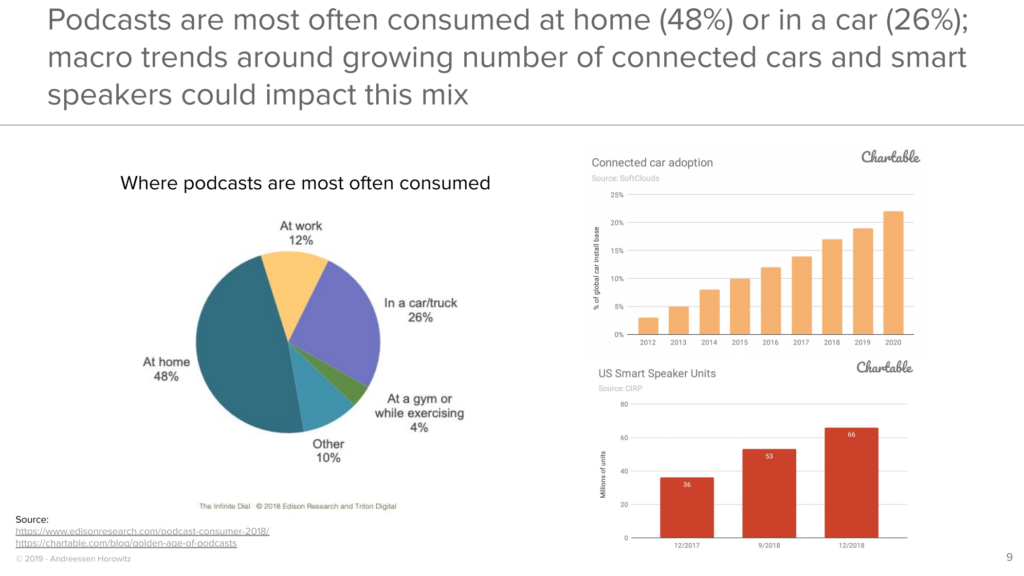
Just think: What are YOU doing outside work hours, in the morning, evening, and on weekends, smartphone in your hand or pocket?
Me, I’m walking the dog, doing the dishes, and preparing my 6-month-old daughter’s bottles and fruit or veggie goop for tomorrow. I’m doing laundry or taking out the trash. I’m driving my wife to and from the train station or my daughter to and from daycare, or I’m heading to and from the closest coffee shop. (Greetings from a Starbucks in Rye Brook, NY, by the way.)
When we recognize that people listen on their phones AND mainly do so when they’re not at work, we face a very real opportunity: We can reach and resonate with our audience in a different part of their day, when all our other marketing efforts are usually for naught.
I’m reminded of something Eric Schmidt, former CEO and exec. chairman of Google, once said, back when he was the company’s chief executive. I was working at Google at the time, watching Schmidt give an interview on national TV. The reporter asked about how the company could justify the big investment in perks like food and laundry and other life-related services.
“Well, it’s quite simple,” started Schmidt, ever the philosopher-executive. “If you’re worrying about where you’re getting your lunch or how you’ll find time to do your laundry, you’re not focused on your work.” Schmidt smiled as if to warm up the crowd before dropping this next bomb just as thoughtfully as the previous sentence. “And we want you focused on your work all the time.”
Look, realistically, people won’t focus on our brand all the time, or even most of the time. That’s wildly unrealistic to expect. But that doesn’t mean we’ve maximized our ability to serve them and add value to their lives with the content we currently create. Given when and how people listen to podcasts (namely, outside of work, and on their phones), we’re able to expand the time our audience spends with us.
To better capitalize on this opportunity, ask yourself:
- Which parts of our audience’s day do we want to own and why?
- How does that shape the concept of the show, as well as the format and runtime of the episodes we publish? (Trying to tap into the commute? The average commute in the US is just under 30 minutes. Want to own the gym? Maybe make it shorter and snappier.)
- What competitive set are we up against, given that daypart? (Looking at the mornings? Be careful. You’re up against hugely popular shows like the New York Times’s The Daily. Better bring your A-game, or maybe complement those factual interview-based shows with stories. Give them some inspiration instead — a kick in the butt to say, “Go get ’em today, you ol’ so-and-so!”)
- Lastly, and most crucially, do we MESSAGE the fact that we’re airing episodes when we do? When can audiences expect to hear from us, even if they choose to wait according to their own whims and schedules? Can we create appointment listening?
2. ‘Cuz We’re Freeeeee … Free List’ning! Free List’ning!
Alright, I’m getting carried away, but podcasting is slowly moving into the terrain currently owned by text, video, and imagery. It’s slowly becoming a freely shared, easily consumed medium. In other words, it’s moving away from every host declaring, “Listen on Apple, Spotify, Google, a million other apps, or wherever you get your podcasts.” The beautiful future we want is for someone to simply say on social media, “Here’s the episode. Take a listen!” And one click later, people can. Ideally, this will help us marketers grow our audiences by directing people to stream from our own websites, rather than inside an app, where we don’t own the experience, can’t prompt email subscription, and run the risk of building our audiences on rented land.
(Facebook brand pages, YouTube channels, and Medium blogs all serve as warnings to marketers: If we build audiences on third party platforms, we’re in danger of the other company changing their algorithm or business model. They don’t care about us. They care about their own business, as they should. So too should we. Don’t rely the organic reach on other platforms. That includes podcast players. You don’t own nor access those listeners directly. You’re limited in what you can share with them and what you can learn from them.)
There’s a reason podcasting is so freely shareable compared to other mediums: RSS. Podcasts rely on RSS readers for distribution, which is what podcast players really are: aggregators technologically capable of sucking in a feed that looks like a bunch of meaningless characters to us and spitting out a listenable episode for our human ears (and hearts, awww). This is why listening apps were previously called “podcatchers.”
This is NOT a good experience, especially for sharing and discovery.
Think about your approach to reading articles. Do you rely on an RSS reader? Maybe! There was a time that Google offered their own, but they killed it years ago. Feedly is another such app. But if you read articles inside an RSS reader, it’s because you chose to do so. Most of us simply click the links we see, and instantly access the content wherever it lives. With podcasts, we have no choice: We NEED the RSS reader, the podcast listening app. We don’t NEED a reading app! Text lives free, everywhere.
Podcasts feel stuck in the dark ages of content sharing and consumption as a result. This makes the sharing and discovery experience of those on the receiving end of your links rather obnoxious. The UX is clunky at best and me-singing-a-parody-of-Tom-Petty-directly-into-your-face bad. (‘Cuz I’m freeeee…!)
Click a podcast link in a social feed, and all hell breaks loose. Sometimes, you’re automatically redirected into your podcast app. Hurray! Other times, you’re prompted to download an app, and sometimes, it’s the app you already have on your phone. Still other times, you’re in a browser view of a player barely optimized for mobile, which also might prevent you from continuing to use your social media app of choice during your listening time. (For instance, clicking links inside Twitter often keeps you in Twitter, replacing your feed view with the browser view. Closing that view means closing the episode, and ending your listening time.)
Just some of the joys of a medium that professes to be free … until you experience it.
Until now!
(Kinda.)
I believe this all starts to change when more technology minds spend more time on this problem. More talent trying to solve the problem prompts more investment dollars to flow towards that talent. More competition prompts everyone to innovate and focus on the user, given the uptick in choice and change in behavior users exhibit. When incumbents don’t face much competition, well, the status quo persists.
Apple Podcasts is THE incumbent in podcast listening apps, and they aren’t exactly looking for audiences to consume podcasts on your brand’s website. They want you inside Apple Podcasts. Spotify wants you in Spotify, Stitcher in Stitcher, and so forth.
One Marketing Showrunners subscriber from a Fortune 500 brand told me recently that he loves podcasting’s status quo because it’s so “decentralized,” in his words. It’s not dominated by a single company. I was literally typing “A-p-p” when I got a second email right away from him. “Well, okay: Maybe Apple.”
I like Apple Podcasts and all these other companies well enough. The problem isn’t Apple, per se. It’s the mechanics of podcast consumption overall. Fortunately, there’s some competition brewing.
On the data side, we no longer “have to” share Apple Podcasts links, or links to any other specific players. Some companies, like Chartable, are trying to solve this problem. Chartable offers a feature called SmartLinks, which presents people who click with a pop-up box, where they can choose their go-to app. It’s still two clicks instead of one, but it’s a start. You can also choose for users to be redirected based on operating system automatically (e.g. iOS users get deposited into the Apple Podcasts app immediately), but there’s no guarantee that just because you use iOS you aren’t using an independent podcast player (as I do) instead of the default app. Lastly, we have an option via SmartLinks to direct the remainder of traffic to our specific website or any link of our choosing.
That’s on the tracking and redirect side of the equation.
Other companies are competing with Apple’s market dominance on the listening side. For starters, there are indies like Overcast, which has long been a beautifully crafted iOS podcast player, built by entrepreneur Marco Arment, a former cofounder of Tumblr. Their clipping feature allows you to crop snippets of any show and share it directly to social media as a listenable video file.
On the opposite end of the spectrum, the publicly traded audio giant Spotify has become a fast-growing player in this market, as the a16z report shows:
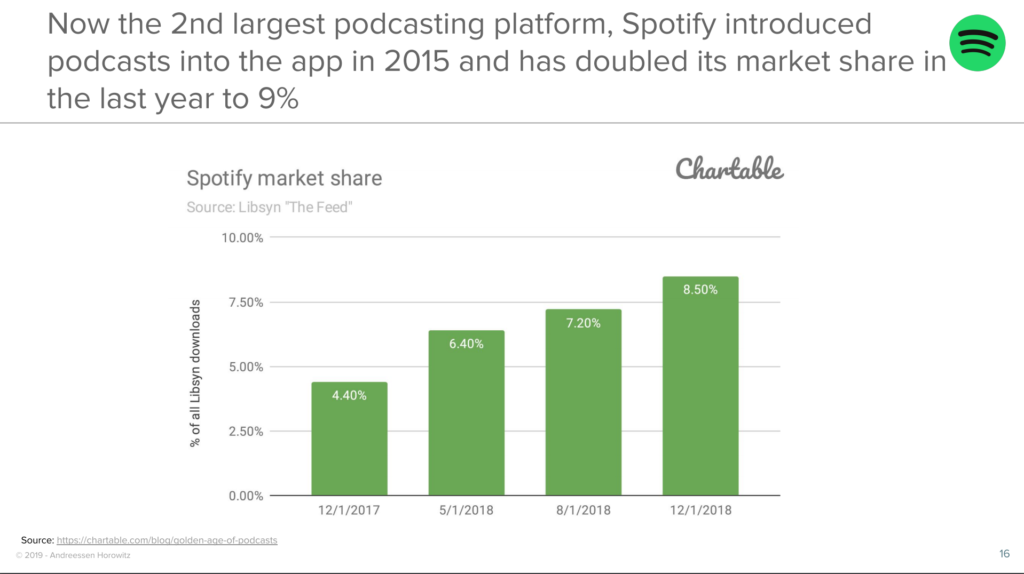
They’re also introducing new people to podcasts, not merely grabbing at the existing pie. Instead, they’re growing the pie:
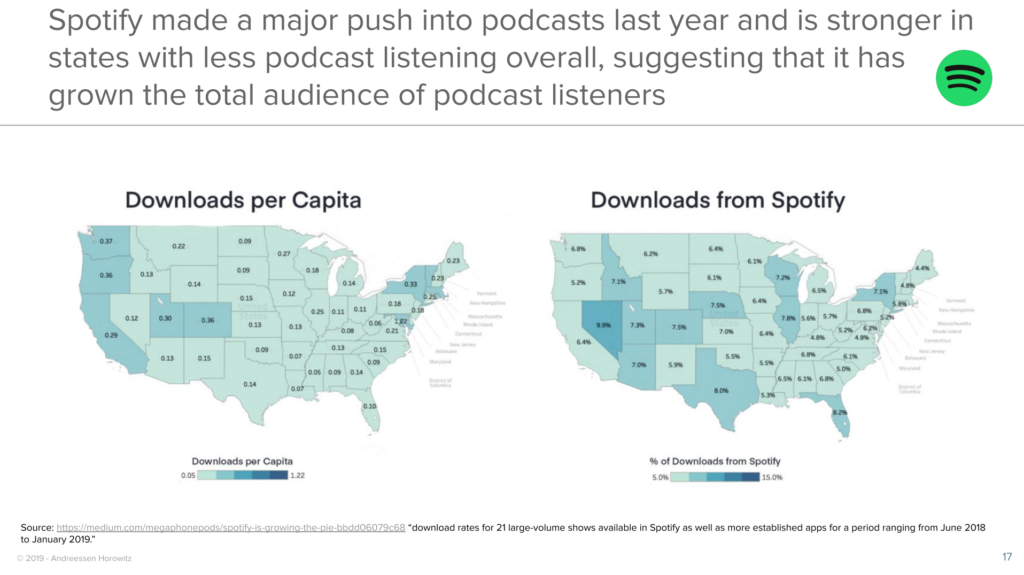
Spotify has reportedly been looking to spend more than half a billion dollars acquiring audio companies, and they’ve acquired a handful in 2019 alone, including the splashy announcements that Anchor and Gimlet Media have joined the big green circle of audio.
All this alone isn’t enough, but it will certainly attract more innovation — as evidenced by the very report we’re discussing here. Andreessen Horowitz is a premier firm investing in software companies. The fact that they published this bodes well for this industry pushing beyond older norms on the technical side, which bodes well for the listener experience … and our ability as marketers to share, grow, and measure our shows.
Here’s to a more free future for audio content and a better user experience.
In the meantime, let’s maybe pool our resources to launch the startup Wherever You Get Your Podcasts. Because, hey, free marketing on every show!
Ask yourself:
- Are we pushing one app or link too much?
- Do we have a strategy for streams, not downloads?
- Are we building our audience on rented land, a third party app we don’t control? Can we better own our podcast audiences and subscribers, thus measuring ROI more effectively?
3. A Brand’s D&I Efforts Must Include Their Show
Question: What do you call two white men talking?
Answer: A podcast!
(Oh no.)
Follow the logic here: Want to stand out? Create an original show. Original shows require more creative thinking to execute. Creativity requires a diversity of perspectives to mold and improve the work. Want to stand out? Ensure the team behind the show is diverse, in all senses of the word.
Diversity and inclusion initiatives matter in your hiring, yes, but they should also be doubly focused on your shows, given the data. So, in addition to just plain being the right thing because, yanno, #humans, we need to create a world where this slide never exists again…
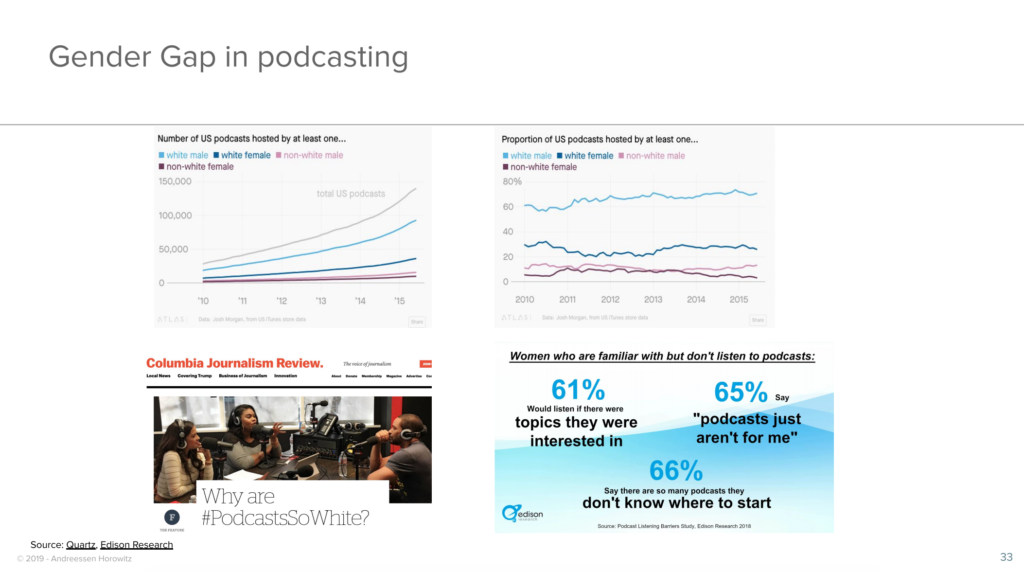
Just as we have a glut of expert interview shows, we have a glut of white dudes hosting and appearing on shows. We need new voices, both as talent and as interview subjects. Make a concerted effort to bring a new perspective into the world through your show. This just plain makes for a great show. You wouldn’t want the same old experts on every show in your niche, right? (Even though this happens, we should fight to take new angles with existing experts, or find new people to profile entirely.) That’s a direct line towards promoting more diversity on the show.
If you’re not personally bringing new voices into the world as a host or interviewer, add a co-host, or create a miniseries within your feed. Ensure your show isn’t purely male guests, or however else you’d look at diversity and inclusion.
Again, diversity is always the right thing overall, but just in case someone out there needs the extra nudge: study after study reveals that creativity requires diversity of perspective and that diversity of perspective drives business results. Keep D&I in mind. It’s so much more than an HR thing. Your audience and your results will tell you: This is good for people, and good for business.
4. Not ready to make a show? Advertising on shows may work, but…
…true success might mean ditching the desire for “scalable” or “efficient” advertising methods, i.e. programmatic media buys more similar to video or banner ads.
If we look at the data, and talk to just a few show hosts, we can craft a better strategy and become early movers with a better approach than programmatic, giving us distinct advantages that others haven’t captured yet.
To do so, first, consider the revenue flowing (or not flowing) into podcasting. This medium currently lags way behind others in advertising dollars captured, partly due to its smaller size in general, and partly due to its newness to most advertisers, I’d guess.
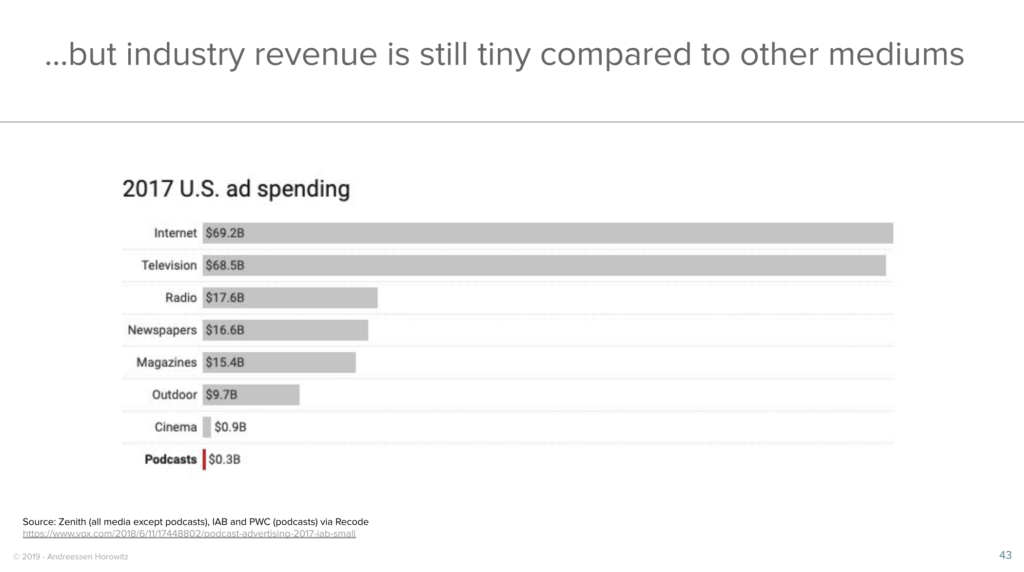
However, podcast ads can be quite effective compared to other forms of advertising:
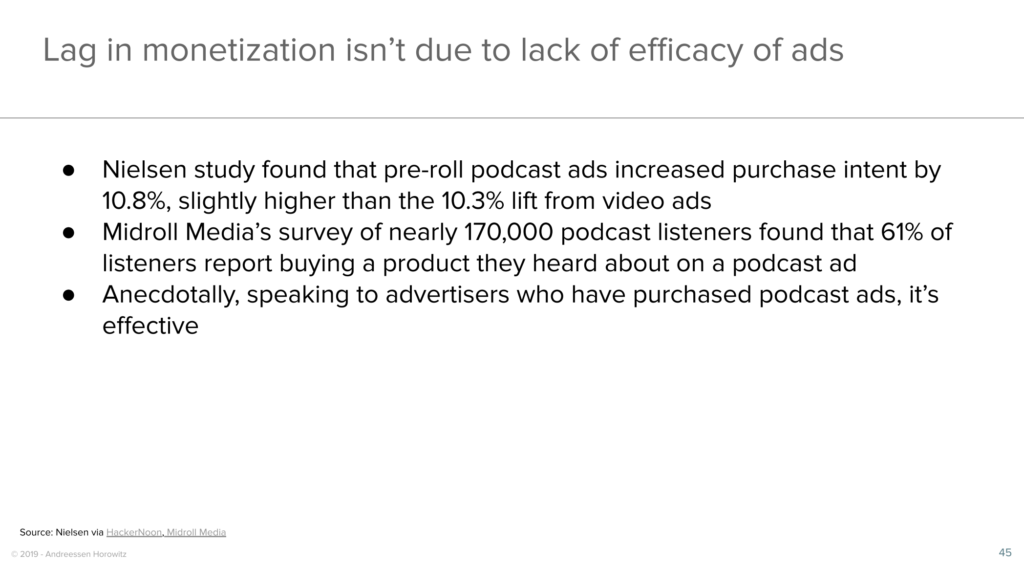
So if I’m a brand thinking of running ads, I’m thinking about the psychology of this market first, then crafting my strategy.
With a few exceptions, podcasters yearn for true partners instead of programmatic ads, as the latter only rewards download totals. A show, however, isn’t about pure reach. It’s about resonance. It’s not about appearing in front of someone for a few seconds but about earning trust with them over time. The same belief that drives Marketing Showrunners as an org applies to how brands should approach podcast advertising: Great marketing isn’t about those who arrive. It’s about those who stay.
So, what can you, a marketer, do with her, a podcaster, to benefit from a loyal, engaged audience over time? Treat it like a sponsorship and a partnership, rather than transactional advertising. Do that, and suddenly, you unlock value your brand would never have captured before. Best of all, you can compete with a lower marketing budget, because you’re able to approach smaller shows with passionate audiences who aren’t weighing your offer against Casper, Seat Geek, Squarespace, or Ziprecruiter. You get out of the pure CPM-based purchase. This is a flat fee or project-based way to sponsor.
Let’s use an example with my show. I host a narrative-style podcast that receives a few thousands downloads per episode, Unthinkable. It’s hard to create, sounds different (and better) than lots of other business shows that stop at talking heads, and the audience is wildly passionate about the show. However, the CPM model and programmatic ad slots make zero sense for me. The math won’t work until I generate tens of thousands or hundreds of thousands of downloads. To do that, it’d inevitably dilute the show, which means lessening the trust and loyalty of listeners. Even if I did manage to retain that relationship, simply reading about a brand a few times an episode would feel like I was transacting my audience after years of earning their trust and serving them and only them.
But were a brand approach me as a true partner, instead of a “marketing channel,” suddenly, the value I’d add back to them ratchets up to 11. What could we do together over time? Well in addition to bespoke ad reads, maybe a miniseries about a topic they care about (sponsored content). Maybe a recurring cast of characters: their CMO, their head of X, their most valuable agency partners, etc., all appearing on the show. Maybe a behind-the-scenes series with them as ride-along guests, or a co-hosted slot with a marketer from their team, or co-created and co-marketed content pulling lessons from the show, available on the brand’s website … or any number of new initiatives that create genuine value for the audience and thus more value for the brand.
Understand: The money in podcasting currently flows to massive shows pretty much exclusively. Everyone else scrapes by, and they wear those scratches and bruises like badges of pride. But the first marketer to arrive in a podcaster’s inbox and just admit that it’s a struggle will win. Look, I get it: It’s a slog, and straight advertiser reads feel a little too transactional between you and the audience. I get that it’s hard to monetize given the CPM model. Let’s talk about a partnership in addition to ads, and what additional value we can create for each other.
HOLY FORKING SHIRTBALLS. You’ve just created a vocal, passionate, public partner for life.
Yes, this is less efficient in terms of placing your message in front of people. However, it’s far more efficient down your funnel, because everyone you do reach will be more likely to trust and love your brand and take action on your behalf. And isn’t that our real goal as marketers in the end?
Ask yourself:
- Are we treating podcasters as people or channels? Can we approach them as partners, as analysts/experts/influencers, instead of as an audio form of websites where run banner ads?
- Can we earn trust, rather than try to purchase it? How might show hosts, as experts in earning trusts, become lifelong allies and fans of our brand and our mission?
- What can we do to re-frame podcast sponsorship as a partnership instead of a purchase?
Get more insights and analysis on all things related to making branded original series. Join some of the top minds in marketing who receive the MSR monthly newsletter. Subscribe below:
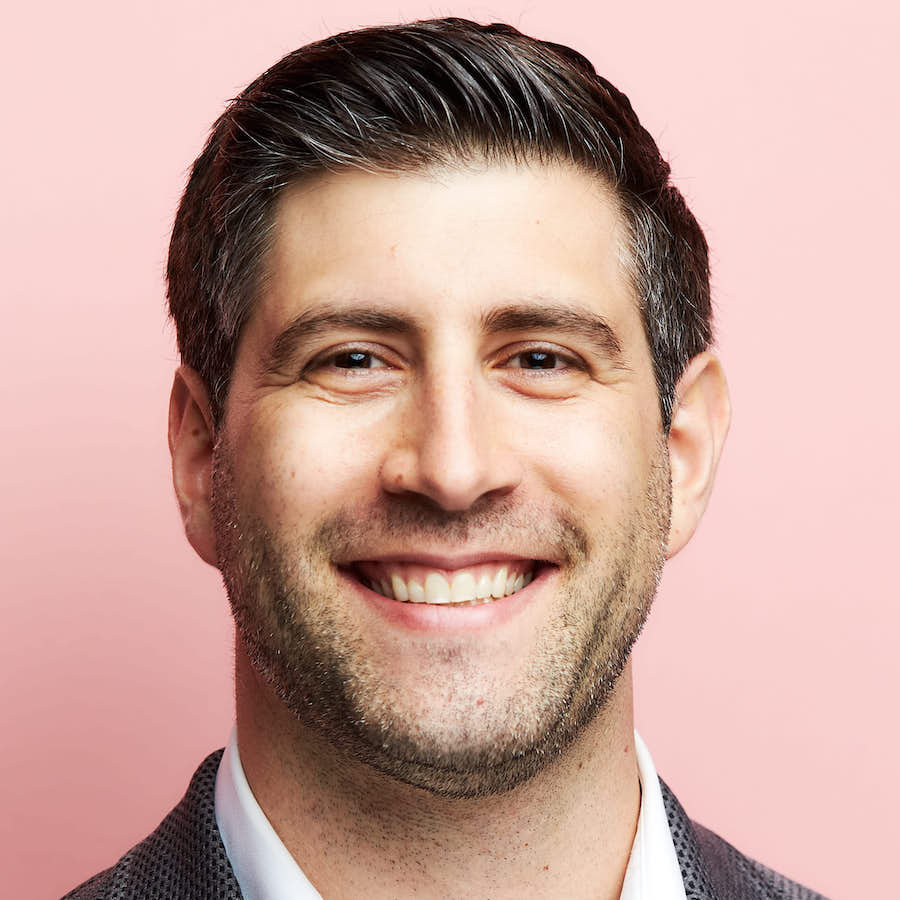
Founder of Marketing Showrunners, host of 3 Clips and other podcasts and docuseries about creativity, and author of Break the Wheel. I’m trying to create a world where people feel intrinsically motivated by their work. Previously in content marketing and digital strategy at Google and HubSpot and VP of brand and community at the VC firm NextView. I write, tinker, and speak on stages and into microphones for a living. It’s weird but wonderful.
Get in touch anytime: jay@mshowrunners.com // Speaking inquiries: speaking@unthinkablemedia.com

